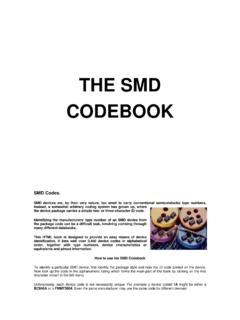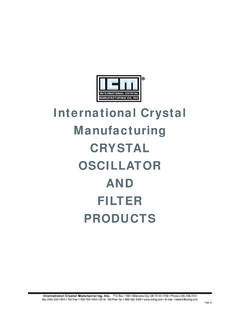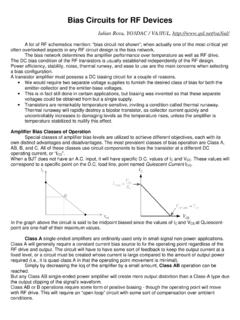Transcription of THE SMD CODEBOOK - Sphere
1 THE SMD. CODEBOOK . SMD Codes. SMD devices are, by their very nature, too small to carry conventional semiconductor type numbers. Instead, a somewhat arbitrary coding system has grown up, where the device package carries a simple two- or three-character ID code. Identifying the manufacturers' type number of an SMD device from the package code can be a difficult task, involving combing through many different databooks. This HTML book is designed to provide an easy means of device identification. It lists well over 3,400 device codes in alphabetical order, together with type numbers, device characteristics or equivalents and pinout information.
2 How to use the SMD CODEBOOK To identify a particular SMD device, first identify the package style and note the ID code printed on the device. Now look up the code in the alphanumeric listing which forms the main part of this book by clicking on the first character shown in the left-menu. Unfortunately, each device code is not necessarily unique. For example a device coded 1A might be either a BC846A or a FMMT3904. Even the same manufacturer may use the same code for different devices! If there is more than one entry, use the package style to differentiate between devices with the same ID code.
3 This compilation has been collected from R P Blackwell G4 PMK, manufacturers' data and other sources of SMD. device ID codes, pinout and leaded device equivalent information. The entries under the Manufacturer column are not intended to be comprehensive; rather they are intended to provide help on locating sources of more detailed information if you require it. ID Code Variations Many manufacturers use an extra letter as their own identification code. If the device is from Philips it will sometimes have a lower case 'p' (or sometimes 't') added to the code; Siemens devices usually have a lower case 's'.
4 For example, if the code is 1A, according to the table there are a number of possibilities: 1A BC846A Phi ITT N BC546A. 1A FMMT3904 Zet N 2N3904. 1A MMBT3904 Mot N 2N3904. 1A IRLML2402 IR F n-ch mosfet 20V This has been a problem in the past, however recently manufacturers have been adding lower case letters which clarify the code. Many recent Motorola devices have a small superscript letter after the device code, such as SAC . (This smaller letter is merely a month of manufacture code.). Many devices from Rohm Semiconductors which start with G have direct equivalents found in the rest of the number.
5 For example GD1 is the same as D1 which is a BCW31. Some devices have a single coloured letter (usually on extremely small diode packages). Colour, if significant, is shown in small type after the code letter. An 'L' suffix usually indicates a low-profile package, such as an SOT323 or SC70. SOT323. SC70. Reverse joggle devices do present a few problems. They oftern have an 'R' in the type number. A reverse package is one where the lead have been bent up instead of down. So it's a mirror image of a conventional device. Identification is usually possible from the code number, but some manufacturers use the same code.
6 In these cases, it's a case of looking at the device with a magnifying glass. The leads of most normal packages come out closer to the circuit board side of the device; conversely a reverse joggle package will have them coming out closer to the 'top' of the device. Sometimes a series of devices, derived from the same die, have related type (not code) numbers. Often an 'R' will indicate a reverse joggle package, and/or a 'W' indicate a smaller package variant, such as SOT343. Sometimes similarities are also found in the code numbers. For example: Recently some manufacturers have used a symbol or lower case letter to indicate the country of manufacture.
7 These have been ignored in the alphabetical ordering. For example: '67' is the code for a BFP67 (SOT143 package) , '67R' is the code for the reverse joggle variant BFP67R (SOT143R), 'W67' is the code for a SOT343 package version. SOT143. 'Z-S' and 'ZtS ' are both 2PC4081Q devices made by Philips; the first made in Hong Kong and the second in Malaysia; this appears in the CODEBOOK classified under ZS. Leaded equivalent device and information Where possible, the listing gives the part number of a conventional wire-leaded device with equivalent characteristics. If the leaded device is well-known then no more information is given.
8 If the device is less common, some additional information will sometimes be given. Where no exact leaded equivalent exists, a brief device description is given, which may be sufficient to allow substitution with another device. When describing device characteristics, some terms are implied from the type of device. For example, a voltage specified for a rectifier diode is usually the maximum PIV (peak inverse voltage) of the diode, but for a zener diode the operating (zener voltage) will be given. Normally, where a voltage, current or power is specified, these will be limiting values. For example, a device specified as NPN 20V 1W is a NPN transistor with a Vce (max) of 20V, maximum collector current of 100mA.
9 And a maximum total power dissipation of 1W. Some of the transistors are types with integrated resistors; in the list, a base resistor means a resistor connected in series with the base. When two resistor values are given, the first is the series base resistor, and the second the resistor between base and emitter. Digital Transistors (dtr). These are transistors with built-in resistors. Some have one resistor between base and emitter, others in series with the base. Many others have both. To keep things simple, the series resistor is called R1 and the base emitter resistor is called R2. If both are present, then two values are given, R1 first.
10 So 4k7 + 10k means that R1 (the base resistor) is 4k7 and R2 (the resistor between base and emitter) is 10k. Conclusion Identifying the manufacturers' type number of an SMD device from the package code can be a difficult task, involving combing through many different databooks. This HTML book is designed to provide an easy means of device identification. Abbreviations amp amplifier atten attenuator a anode b base c cathode ca common anode cc common cathode comp complement d drain dg dual gate dtr digital transistor (see CODEBOOK introduction). enh enhancement (mode - FETs). fet field effect transistor fT transition frequency GaAsfet Gallium Arsenide field effect transistor g gate gnd ground gp general purpose hfe small signal current gain i/p input Id drain current Ig gate current Ir reverse leakage current (diodes).









